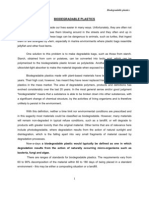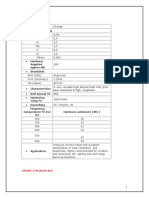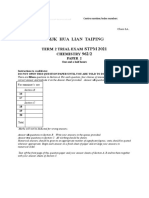BIOPLASTIC
BIOPLASTIC
Uploaded by
Jenny Rose BatalonCopyright:
Available Formats
BIOPLASTIC
BIOPLASTIC
Uploaded by
Jenny Rose BatalonOriginal Title
Copyright
Available Formats
Share this document
Did you find this document useful?
Is this content inappropriate?
Copyright:
Available Formats
BIOPLASTIC
BIOPLASTIC
Uploaded by
Jenny Rose BatalonCopyright:
Available Formats
BIOPLASTIC
Bioplastic simply refers to plstic mde from plant or other biological material instead of
petroleum. It is also often called bio-based plastic.
A bioplastic is a substance made from organic biomass sources, unlike conventional plastics
which are made from petroleum. Bioplastics are made by a number of different processes. Somw use a
microorganism to process base materials, such as vegeteble oil, cellulose, straches acids and even
alcohols.
While almost all bioplastics produce less carbon dioxide in production than conventional plastic,
they are not necessarily completely green. The methods by which their base materials are grown and
the processing involved both impact their product footprint. Many bioplastics also release carbon
dioxide or monoxide when biodegrading. Nevertheless, their overall environmental impact is typically
lower than that of conventional plastics, and as oil costs rise, their cost becomes more and more
competitive.
Some biodegradable bioplastics can break down in 180 days, given the right conditions. Others
are not biodegradable at all. This capcity is desirable, for example, for outdoors applications where
longetivity and a reduced carbon footprint in production may be the goals.
About 8% of the world's oil is used to make plastic and proponents of bioplastic often tout a
reduction in this use as a major benefit. However, there are bio-based plastics that are ultimately better
for the environment than the oil-derived ones.
Researchers studied this issue and introduced a new bioplastic which serves as a natural
fertilizer. Bioplastic is fully biodegradable, vut it also breaks down into the environment after two weeks
and releases plant nutrient into the soil that support plant growth.
This bioplastic that researchers are working on is made by combining 10 mL of distilled water,
1mL of white vinegar, 1.5 g of cornstarch, 0.5 g of glycerol and banana peels. Water plays an important
role in the production of bioplastic. First, it acts as a solvent to dissolve the starch. Secondly, it helps the
starch molecules to stay disrupted after heating. Vinegar a 6% in volume solution of acetic acid liberates
acetate ions and hydrogen ions in solution. Glycerol has also its role in the production of bioplastic
because bioplastic contains carbon, hydrogen and oxygen and these are effective in increasing soil
organic carbon content. Banana peel is also an important ingredient beacause of its effectiveness on
plant as a fertilizer.
You might also like
- Edible CoatingDocument25 pagesEdible CoatingbabaloseNo ratings yet
- Cambridge IGCSE™ Chemistry Practical Skills Workbook (Bryan Earl, Doug Wilford)Document146 pagesCambridge IGCSE™ Chemistry Practical Skills Workbook (Bryan Earl, Doug Wilford)Sterling Acheampong100% (12)
- BIOPLASTICDocument16 pagesBIOPLASTICHarry Firdaus100% (1)
- BioplasticDocument5 pagesBioplasticclaire bernadaNo ratings yet
- Bioplastics and Global SustainabilityDocument3 pagesBioplastics and Global SustainabilityopabalekeNo ratings yet
- Bioplastics As Better Alternative To Petroplastics and Their Role in National Sustainability: A ReviewDocument8 pagesBioplastics As Better Alternative To Petroplastics and Their Role in National Sustainability: A ReviewEzanaNo ratings yet
- ResearchDocument10 pagesResearchSamantha Vhiel VicenteNo ratings yet
- Biodegradable PlasticDocument24 pagesBiodegradable PlasticAin SoberanoNo ratings yet
- Synthesis of Bioplastic of Cassava StarchDocument3 pagesSynthesis of Bioplastic of Cassava StarchIjan HeyNo ratings yet
- A. Local Related Literature and StudiesDocument7 pagesA. Local Related Literature and StudiesYsay SomeraNo ratings yet
- By-Product From Rice Mill, Rice Husk, Rice Bran and Its UtilizationDocument28 pagesBy-Product From Rice Mill, Rice Husk, Rice Bran and Its UtilizationbalajimoviesNo ratings yet
- Making Bioplastics: Delaney Sullivan Undergraduate, Department of Biology Stanford UniversityDocument12 pagesMaking Bioplastics: Delaney Sullivan Undergraduate, Department of Biology Stanford UniversityArv InNo ratings yet
- Factsheet On Bioplastics 230309Document7 pagesFactsheet On Bioplastics 230309a3004448No ratings yet
- Biodegradable PlasticsDocument10 pagesBiodegradable PlasticsAnkush KambleNo ratings yet
- Biosurfactants in Food IndustryDocument8 pagesBiosurfactants in Food Industry2begeniusNo ratings yet
- Poster CakkkomDocument1 pagePoster CakkkomJihan Mutiah0% (1)
- Finalss 1Document42 pagesFinalss 1Jeremie Silawan MagalingNo ratings yet
- Biodegradable Plastic Liquid AdditiveDocument1 pageBiodegradable Plastic Liquid AdditiveBiodegradablePlasticNo ratings yet
- Bioplastic Production Utilizing Soybean HullsDocument17 pagesBioplastic Production Utilizing Soybean HullsAlberto Suarez100% (1)
- Biobased Polymers in Europe PDFDocument249 pagesBiobased Polymers in Europe PDFOmar Paúl Troncoso HerosNo ratings yet
- Research Format - QuantitativeDocument29 pagesResearch Format - QuantitativeRichelle CastanedaNo ratings yet
- 2 Plastics IndustryDocument41 pages2 Plastics IndustrystephendixNo ratings yet
- Bio-Degradable PackagingDocument14 pagesBio-Degradable PackagingPBNo ratings yet
- Biodegradable Plastic PDFDocument16 pagesBiodegradable Plastic PDFAgustine Christela Melviana100% (1)
- Utilization of Avocado Seed (Persea Americana) As A Bioplastic Food WrapperDocument10 pagesUtilization of Avocado Seed (Persea Americana) As A Bioplastic Food Wrappermagalongshaina01No ratings yet
- Recycling of Plastic Waste - Presence of Phthalates in Plastics From Households and IndustryDocument9 pagesRecycling of Plastic Waste - Presence of Phthalates in Plastics From Households and IndustryEric ChangNo ratings yet
- PolystereneDocument3 pagesPolystereneAlbert Julius VlogsNo ratings yet
- BioplasticsDocument4 pagesBioplasticsBeverly RamosNo ratings yet
- Bioplastic Recipes IngredientsDocument8 pagesBioplastic Recipes IngredientsLatika Sharma100% (1)
- Bio BasedDocument10 pagesBio Basedemporio72No ratings yet
- Bio Based PolymersDocument16 pagesBio Based PolymersMisael Abdias Millan AlonzoNo ratings yet
- Chapter One 1.1 Background of StudyDocument47 pagesChapter One 1.1 Background of StudyChinwuba Samuel EbukaNo ratings yet
- Chem Eng Technol - 2020 - Sarangi - Biohydrogen Production Through Dark FermentationDocument12 pagesChem Eng Technol - 2020 - Sarangi - Biohydrogen Production Through Dark Fermentationseronoser4020No ratings yet
- Brosch - Biokunststoffe Web v01 - 1 PDFDocument68 pagesBrosch - Biokunststoffe Web v01 - 1 PDFMike AndersonNo ratings yet
- BiopolymerDocument14 pagesBiopolymerMuhd FaizNo ratings yet
- A Mini Project OnDocument31 pagesA Mini Project Onvikas guptaNo ratings yet
- Modified Atmosphere Packaging - A Progressive Technology For ShelfDocument28 pagesModified Atmosphere Packaging - A Progressive Technology For ShelfGuillermo Marcelo Badillo MuñozNo ratings yet
- Environmental Biodegradation of Synthetic Polymers I. Test Methodologies and ProceduresDocument16 pagesEnvironmental Biodegradation of Synthetic Polymers I. Test Methodologies and ProceduressonchemenNo ratings yet
- Usage of Potential Micro-Organisms For Degradation of PlasticsDocument9 pagesUsage of Potential Micro-Organisms For Degradation of PlasticsLaysothea ChhoukNo ratings yet
- Review On Plastic Wastes in Marine Environment - Biodegradation and Biotechnological SolutionsDocument8 pagesReview On Plastic Wastes in Marine Environment - Biodegradation and Biotechnological SolutionsDevita AmeliaNo ratings yet
- Eco-Friendly Adhesives From Vegetable OilsDocument3 pagesEco-Friendly Adhesives From Vegetable Oilsgem119198No ratings yet
- Biodegradable PolymersDocument4 pagesBiodegradable PolymersArnela HodzicNo ratings yet
- Biosurfactant by PseudomonasDocument18 pagesBiosurfactant by Pseudomonassunita dangeNo ratings yet
- ChitosanDocument22 pagesChitosanDewi Azizah Sulaksana100% (1)
- Bioplastics CompoundingDocument45 pagesBioplastics Compoundingchristopher_kephart1100% (1)
- Biopolymer S 2Document20 pagesBiopolymer S 2Armando Cauich ChanNo ratings yet
- Bio FuelDocument53 pagesBio FuelhvmandaliaNo ratings yet
- Bio LeachingDocument12 pagesBio LeachingAayush ShirsawadeNo ratings yet
- Kim Et Al 2023 A Review of Biodegradable Plastics Chemistry Applications Properties and Future Research NeedsDocument25 pagesKim Et Al 2023 A Review of Biodegradable Plastics Chemistry Applications Properties and Future Research NeedsAyesha WasimNo ratings yet
- Plastics Ban and Its RecyclingDocument26 pagesPlastics Ban and Its RecyclingAlliedschool DefencecampusNo ratings yet
- Anaerobic DigestionDocument109 pagesAnaerobic DigestionAjaysingh BayasNo ratings yet
- Production of Biodegradable Plastic From Banana PeelDocument7 pagesProduction of Biodegradable Plastic From Banana PeelKeanne MiguelNo ratings yet
- Analysis of Biodegradation of Bioplastics Made of Cassava StarchDocument15 pagesAnalysis of Biodegradation of Bioplastics Made of Cassava StarchBrynt Yuan Lord PlacidesNo ratings yet
- Bioplastics: Chemistry Investigatory ProjectDocument16 pagesBioplastics: Chemistry Investigatory ProjectDhanyaa vaitheeswaranNo ratings yet
- Disadvantage of PlasticDocument3 pagesDisadvantage of Plasticamolmob87No ratings yet
- Algalbiofuelgrouppresentation 191030192132 PDFDocument32 pagesAlgalbiofuelgrouppresentation 191030192132 PDFPio Casmir0% (1)
- Basic BioluminescenceDocument13 pagesBasic BioluminescenceArup DasNo ratings yet
- Facts About PET - 25 March 2013Document7 pagesFacts About PET - 25 March 2013Cátia CoelhoNo ratings yet
- Polymer Nanocomposites based on Inorganic and Organic NanomaterialsFrom EverandPolymer Nanocomposites based on Inorganic and Organic NanomaterialsSmita MohantyNo ratings yet
- Bio-Based SolventsFrom EverandBio-Based SolventsFrançois JérômeNo ratings yet
- An Acrostic PoemDocument1 pageAn Acrostic PoemJenny Rose BatalonNo ratings yet
- Basura Ko Responsibilidad Ko1Document2 pagesBasura Ko Responsibilidad Ko1Jenny Rose BatalonNo ratings yet
- Aking Tatayahin:: Jenny Rose Batalon Grade 11-Humss Dickens October 19, 2021Document4 pagesAking Tatayahin:: Jenny Rose Batalon Grade 11-Humss Dickens October 19, 2021Jenny Rose BatalonNo ratings yet
- Game Description:: Jenny Rose Batalon Grade 10 - Socrates 11/07/20Document2 pagesGame Description:: Jenny Rose Batalon Grade 10 - Socrates 11/07/20Jenny Rose BatalonNo ratings yet
- Biodiversity and Evolution-WorkbookDocument9 pagesBiodiversity and Evolution-WorkbookJenny Rose BatalonNo ratings yet
- GRADE 10 SOCRATES Weekly Home Learning PlanDocument3 pagesGRADE 10 SOCRATES Weekly Home Learning PlanJenny Rose BatalonNo ratings yet
- Jenny Rose L. Batalon: Grade 10-SocratesDocument1 pageJenny Rose L. Batalon: Grade 10-SocratesJenny Rose BatalonNo ratings yet
- The Efficacy of Glycerol (Propane-1,2,3-Triol) As A Detection Substance For Gram-Negative Bacteria (Vibrio Cholerae)Document6 pagesThe Efficacy of Glycerol (Propane-1,2,3-Triol) As A Detection Substance For Gram-Negative Bacteria (Vibrio Cholerae)Jenny Rose BatalonNo ratings yet
- News ReportDocument4 pagesNews ReportJenny Rose BatalonNo ratings yet
- CHEMICAL BONDING-workbokDocument9 pagesCHEMICAL BONDING-workbokJenny Rose BatalonNo ratings yet
- Weekly Pinggang Pinoy Challenge S.Y. 2019-2020: Monday TuesdayDocument1 pageWeekly Pinggang Pinoy Challenge S.Y. 2019-2020: Monday TuesdayJenny Rose BatalonNo ratings yet
- Banana Peel - WikipediaDocument20 pagesBanana Peel - WikipediaJenny Rose BatalonNo ratings yet
- Carlos Botong FDocument1 pageCarlos Botong FJenny Rose BatalonNo ratings yet
- The Efficacy of Glycerol Propane 123 Triol As A Detection Substance For Gram Negative Bacteria Vibrio Cholerae SIP Grade 10 SOCRATES GROUP1Document21 pagesThe Efficacy of Glycerol Propane 123 Triol As A Detection Substance For Gram Negative Bacteria Vibrio Cholerae SIP Grade 10 SOCRATES GROUP1Jenny Rose BatalonNo ratings yet
- Stomata - This LDocument2 pagesStomata - This LJenny Rose BatalonNo ratings yet
- Hot Work Tool Steel: Colour Code Typical AnalysisDocument6 pagesHot Work Tool Steel: Colour Code Typical Analysisanirudha_jewalikar1No ratings yet
- Silver Catalyst 199948Document4 pagesSilver Catalyst 199948derimanaNo ratings yet
- Orgchem Module Edit 2Document74 pagesOrgchem Module Edit 2Nur-aine HajijulNo ratings yet
- Final Presentation Thermal CoatingDocument16 pagesFinal Presentation Thermal CoatingKarimMattaNo ratings yet
- CNG Engine PDFDocument11 pagesCNG Engine PDFFaisal RahmanNo ratings yet
- Macsteel VRN VRN 200 DatasheetDocument1 pageMacsteel VRN VRN 200 DatasheetIgor NhamanoNo ratings yet
- Lubrizonic LZ-1698 TDSDocument1 pageLubrizonic LZ-1698 TDSMuhammad WaqasNo ratings yet
- BRB CM 56 SDocument2 pagesBRB CM 56 SIsrar AnwarNo ratings yet
- Filtration and CrystallizationDocument12 pagesFiltration and CrystallizationDamani RobertsNo ratings yet
- Msds Tds MatrixDocument3 pagesMsds Tds MatrixDominique WNo ratings yet
- Element Yearbook - Mta ChemDocument3 pagesElement Yearbook - Mta Chemapi-1984458000% (1)
- Multiple Choice QuestionsDocument35 pagesMultiple Choice QuestionsShahbaz Ahmed RanaNo ratings yet
- Metals and Nonmetals Work Sheet - 1: Chemistry Worksheets - Class - XDocument6 pagesMetals and Nonmetals Work Sheet - 1: Chemistry Worksheets - Class - Xrita soniNo ratings yet
- Geotextiles DatasheetDocument1 pageGeotextiles DatasheetMohammad TalalNo ratings yet
- ANSWER 4 Oral Liquid ValidationDocument8 pagesANSWER 4 Oral Liquid ValidationPankaj JaatNo ratings yet
- Organic Compounds, Classification and Properties: For General Chemistry 1/ Grade 12 Quarter 2 / Week 6Document14 pagesOrganic Compounds, Classification and Properties: For General Chemistry 1/ Grade 12 Quarter 2 / Week 6ariinnggg onichaNo ratings yet
- MS Chemistry Paper 2 TZ2 SL Markscheme-4Document1 pageMS Chemistry Paper 2 TZ2 SL Markscheme-4suryansh AroraNo ratings yet
- 07 ScrewdriversDocument22 pages07 ScrewdriversAnonymous 4MwmDaNbNo ratings yet
- Lms Template - Tutorial Chap 5Document4 pagesLms Template - Tutorial Chap 5LeticiaNo ratings yet
- Term 2 Trial Exam STPM 2021 ANSWERSDocument12 pagesTerm 2 Trial Exam STPM 2021 ANSWERSMuhd FaiZNo ratings yet
- Shell Rimula R2 Multi 25W-50Document2 pagesShell Rimula R2 Multi 25W-50Álgøkár ÁhmēdNo ratings yet
- RPS - 8. Daftar Pustaka 889Document10 pagesRPS - 8. Daftar Pustaka 889Ricky Putra SiregarNo ratings yet
- Lesson Plan For Separation TechniquesEDocument10 pagesLesson Plan For Separation TechniquesEJakie UbinaNo ratings yet
- 01 Natural Sciences PDFDocument13 pages01 Natural Sciences PDFJennifer PesikNo ratings yet
- Study Guide in Che 111: Chemistry For Engineers: Module 3: Nuclear Chemistry and EnergyDocument8 pagesStudy Guide in Che 111: Chemistry For Engineers: Module 3: Nuclear Chemistry and EnergyVenven PertudoNo ratings yet
- CN106047065A - Solvent-Free Epoxy Glass Flake Coating For Sea Splash Zone Steel Structures and Preparation Method Thereof - Google PatentsDocument8 pagesCN106047065A - Solvent-Free Epoxy Glass Flake Coating For Sea Splash Zone Steel Structures and Preparation Method Thereof - Google PatentsAkhtar aliNo ratings yet
- 3/8/12 6:53 PM SCP - Rockwood AdditivesDocument2 pages3/8/12 6:53 PM SCP - Rockwood AdditivesRodrigo PierozanNo ratings yet
- TVL Tools and Equipment NeededDocument1 pageTVL Tools and Equipment NeededKATHERINE IBANEZNo ratings yet
- November 28 - December 02Document3 pagesNovember 28 - December 02harold carbonelNo ratings yet








































































































